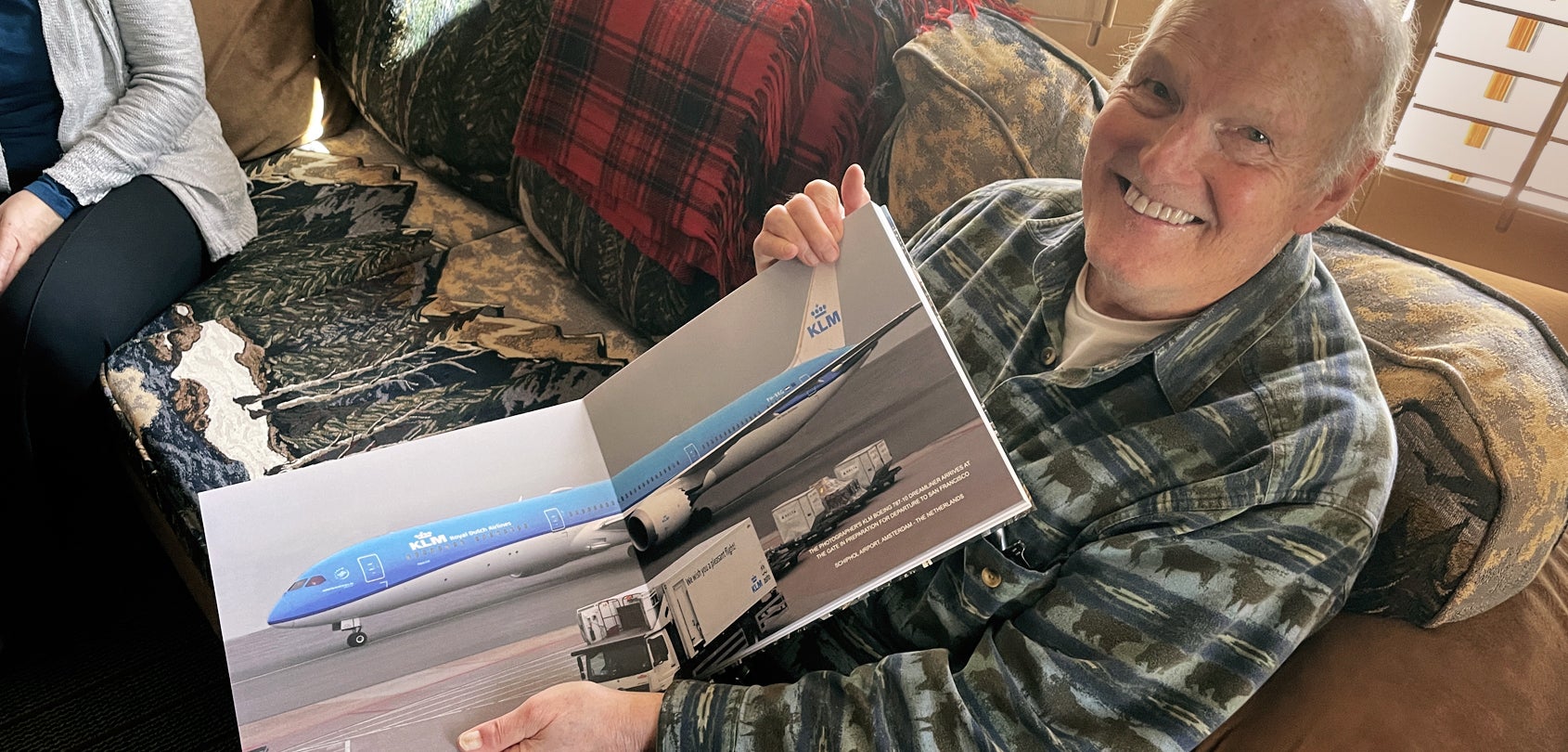
A Lifetime of Travel: Albert Mueller
[image above]
Al Mueller displays one of his photographs in his home 2023
Albert (Al) Mueller, Jr., spent most of his working years as a travel agent. He started his career with independent agencies in Southern California in the 1960s, then opened his own travel agency in the 1970s. He sold his agency and went to work for AAA Travel in Northern California in 1981, where he worked for 25 years until his retirement in 2006. He also briefly worked as a ticket and gate agent for Continental Airlines in 1967 and 1968. Al’s career has been about educating and advocating for his customers and helping them navigate the complicated process of traveling.
From an early age, Al loved travel, specifically airline travel. He began collecting airline memorabilia at the age of eleven after flying from Los Angeles to San Francisco to see family members. His love of flying grew from there.
MUELLER: I made a trip in ’57 to my grandparents on a Western Airlines [Douglas] DC-6B, which was very cool. Loved that. And in ’58 I did it on a United [Air Lines Douglas] DC-6, but then things started changing. In 1959, TWA [Trans World Airlines] announced that they were going to be flying a [Boeing] 707 from L.A. [Los Angeles International Airport] to San Francisco [International Airport]. It was the tail end of Flight 61, which came from Baltimore-Friendship [Airport], landed at L.A. and then went on to SFO. And it left in the afternoon, something like five o'clock. My brother and I were going to be on that plane [Laughs]. I dreamed about it for months and collected ads for TWA and Boeing 707, made a scrapbook out of it. Then the day came. When we got on this plane, it was just amazing to get on this big jet and sit next to a window and take off. It was just magic. I have pictures of that, which you have as well, when we landed. And it made a perfect picture, actually, the way the people are juxtapositioned, getting off the plane. I don't know, I just pulled that one off photo-wise.
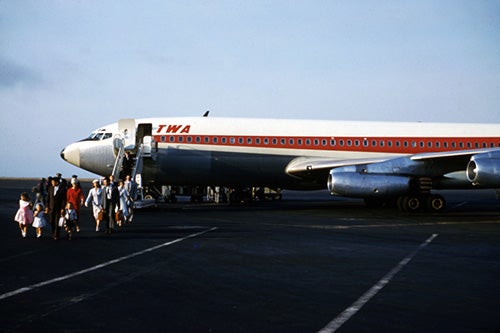
[image]
TWA (Trans World Airlines) Boeing 707-100 at San Francisco International Airport 1959; photo by Albert Mueller
While some kids went to parties, Al would sneak away to fly on different aircraft. In 1960, he went on a journey without his parents’ knowledge.
MUELLER: I booked some flights back and forth between San Francisco and L.A., and back and forth in a day so I could fly on a TWA Convair 880 and United Air Lines [Douglas] DC-8 and, you know, another plane, another plane. Did that back and forth and back and forth. But then things really got out of hand when I told my grandmother that I was going to take the bus up to Petaluma to stay with my aunt and uncle and cousins on their chicken ranch. [Laughs] My parents think I'm at my grandmother's. Instead, I fly back to L.A., and I have booked a Continental 707 to Denver. I'm sixteen years old, and I fly to Denver in first class. I stay at the Denver Hilton. I don't know how a sixteen-year-old checks into a hotel, but it wouldn't happen today. And then the next day I flew back to Los Angeles, and I remember that plane was going to be running late. I kind of panicked because I thought, well, I'm going to miss my connection, my Convair 880 to San Francisco and so forth and so on. I have to call my brother, who's at my grandmother's and let him know I'm going to be late. [Laughs] How do I do that? I didn't have a phone. Well, the Continental people said, “Okay, you go to the pay phone, and you bill our number for the phone call to tell your family that you're running late”… So that worked out. My parents never knew. I don't think I ever told them. Not because I was keeping a secret. And when you're an adult, what difference would it be? That I had slipped away to Denver and was not at my grandparents’, or my aunt’s in Petaluma. But that really kind of got the ball started.
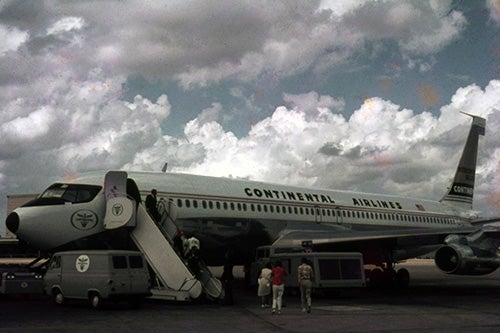
[image]
Continental Airlines Boeing 707-320 “Golden Jet” 1967; photo by Albert Mueller
After a tour of Europe, arranged through a travel agency, his enthusiasm made an impression of Hazel Hanson, owner of Lee Hanson Travel Service.
MUELLER: I knew so much about airline schedules and this and that, and I was learning about hotels, was interested in the hotel business. When I got back, the owner of Lee Hanson Travel Service said, “How would you like to come to work for us part-time?” “Could I go to school too?” “Well, sure.” So I did. I was a gofer. I was filing brochures. I had learned to book hotel air reservations on the phone, because that's what you had to do. And I learned where Mazatlán is, and Puerta Vallarta, places I had never heard of. But booking the Mexicana flights there on the phone, and just doing a lot of stuff, and even typing itineraries. And the travel agency I went to work for was really one of the groundbreaking travel agencies in Southern California. The owner, Hazel Hanson, was known in the business throughout Southern California. She was, I think at one time, the head of ASTA [American Society of Travel Advisors], or the president, that was rotating. It was a whole different experience going to work for them. Because the travel agency business at that time was just really amazing. The travel agents were travel agents. They sat down, and they knew, in fact, the slogan of where I worked, Lee Hanson Travel Service, was “Travel with those who have been there.” And all of the staff were people who had traveled the world. They hadn't always all been everywhere, but if you wanted to go to a certain part of the world where one of them hadn't been, they'd refer you to one of the other agents who had been. And this was a matter of really planning day-to-day activities. When you went to Hawaii, you didn't book a condo in Maui. That didn't exist. What you did typically was – and a lot of people had never been there. They would want the grand tour. So they would go first to Honolulu. They would be met with a lei greeting and a transfer. They would do the Circle Island tour, they would do the luau. They would do the Punchbowl crater tour, the Pearl Harbor cruise. Then they would fly to Kauai, and they would do the Fern Grotto boat cruise trip, and then the Hanelei trip. And then the next day they would go around to [Laughs] to the other area. Waimea Canyon. Then they would fly to Maui. They'd do Iao Valley and out to Kaanapali, where there were only a few hotels, either the Royal Lahaina Hotel, or the Kaanapali Beach Hotel, or the Napili Kai Beach Club. And then they would go to the Big Island, and they would go to the Kona coast, stay at the Kona Inn, then drive the Hamakua coast to Hilo and do the volcano tour. And then they would fly home. This is just the way it was done. And it would all be done by mail. We would type out an itinerary for these particular people, how many nights here and there. We would send it to Roberts Hawaiian Tours, and Maryanne would write back to us about week, ten days, later, you would get the confirmation of the pricing and all this stuff. [Laughs]
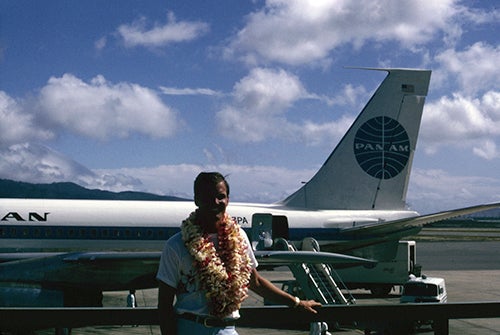
[image]
Albert Mueller standing in front of Pan American World Airways Boeing 707-320 at Honolulu Airport 1967
Al went above and beyond for his customers, often working nights, holidays, and weekends to help his customers with their travel.
MUELLER: I remember one time, I had a fellow going to – and this is when I was at the Diners Fugazy office – and he was going all over Africa to all these capitals that are on Jeopardy now where [Laughs] you’ve never heard of these places. And everything was arranged, all the flights, all the hotels, but his passport was still coming from somewhere. I forgot where. And I remember, it was over a Memorial Day weekend, and I was just miserable thinking that this guy was supposed to leave on Pan Am 120 on Monday, which was at three or four o'clock, something like that. You didn't have check-in four hours ahead, but you had to be there in the morning. I was just beside myself. What happened? We had to get that passport by Monday morning, or we were in big trouble. I went to the post office that morning in Santa Monica, and they took me into the back room, and we went through their bins of letters that hadn't been sorted, looking for this envelope with his passport in it. And there it was. And I called him, and I said, “Russ, we've got it. Get over here and get to the airport” [Laughter]. But those kinds of things, you know, took years off of you.
Al talks in detail about the process of booking airline flights and how that has changed over the years. His job began with hand-writing tickets after looking up the flight number, times, and fares in a large book, the OAG (Official Airline Guide), then accepting cash for the ticket, and the agency would convey payments to the different airlines at the end of the month.
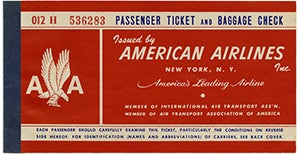
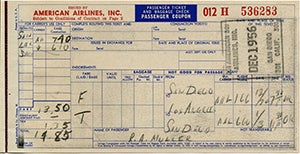
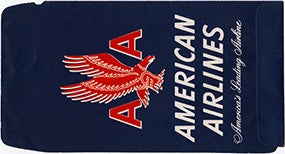
[images]
American Airlines passenger ticket and baggage check December 19, 1956
INTERVIEWER: How did payment happen for the tickets?
MUELLER: Well, most people paid by check or cash. Then you would file a report where you listed them – this is in the earlier stages – you would list them by ticket number and the amount of the ticket, and then list the commission and the net amount that you were paying the airline. You would total it up and cut a check to the airline for that amount. We didn't have any credit cards in the very beginning. There was no such thing as paying with a credit card. I remember when they came out with them, while I was working at the first travel agency in the sixties. We’d all groan, “Oh, it's a credit card sale, and we have to do a credit card charge slip,” and it was a big deal. But in the end, eventually, it was much simpler than collecting cash or a check. So that's how it was done. Like I said, there were different stages. It went from that individual airline reporting, airline by airline. I remember doing the ticket reports myself, putting it in the typewriter, typing the ticket [Laughs]. It was crazy. Then going to a system where they were done as a stack of tickets by serial number with an adding machine tape wrapped around it and sent to what they call ATC, the Air Traffic Conference, with a check for that full amount. And they distributed among the different airlines whose coupons you were mailing to them. It might be a stack like this—
INTERVIEWER: Three or four inches high—
MUELLER: —of just airline receipts with the tape wrapped around it. It went with a transmittal to that ATC processing center that happened in the seventies. And where I worked at AAA in Santa Rosa, I don't know, that was all done in main office, all the accounting of sales.
INTERVIEWER: Presumably, at that point, more people were paying with credit cards.
MUELLER: Oh yeah. We preferred credit cards. [Laughs] It was so much easier.
In addition to his career as a travel agent, Al is an enthusiastic traveler who keeps long lists of all the aircraft and airlines he has flown.
MUELLER: I like the early days, too. You know, the early prop planes on PSA and Western Airlines, DC-6Bs, they were just wonderful planes. We loved flying on them. And my favorite aircraft over the years, aside from Concorde, would be the DC-8. I'm just a great fan of the Douglas DC-8, just because of the sweep of the design of the aircraft, the interior comforts, the big windows. It's just a beautiful plane that I've flown many, many times overseas to Japan and Europe. I just love it. So when people ask, “What's your favorite plane?” I always say the DC-8.
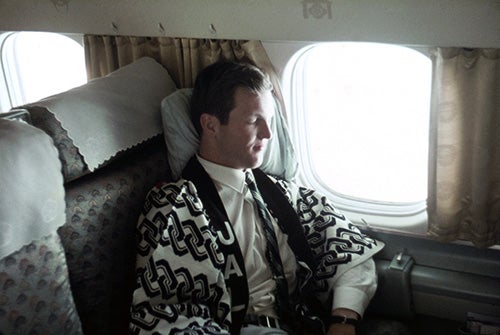
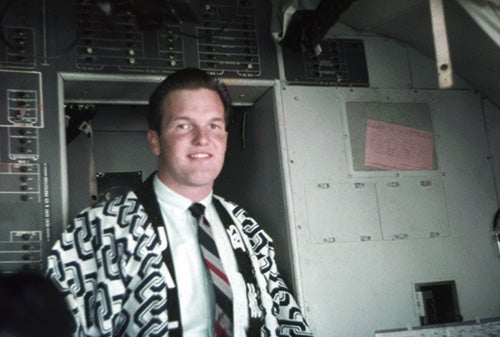
[images]
Al Mueller as a passenger on Japan Air Lines Douglas DC-8 1965
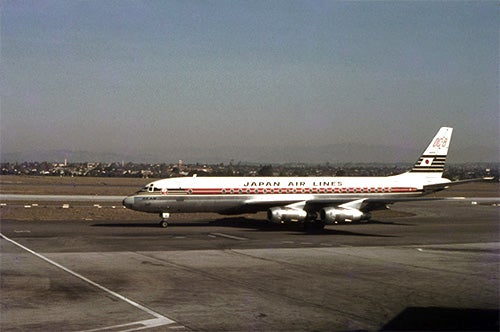
[image]
Japan Air Lines Douglas DC-8-50 Akai 1966; photo by Albert Mueller
In the end, he says, it’s about the people.
MUELLER: Not a week goes by that I don't think of some of my earlier colleagues that I know are long gone, because they were quite a bit older than me at the time. But I learned so much from them. They were just great teachers. I was just so lucky to be hired where I first was hired, to learn the ropes from real professional people. I know that they're long gone, but I think about them so often.
SFO Museum’s Oral History Program captures and shares the first-person accounts of the development of commercial aviation and the role of San Francisco International Airport as a global gateway in service to its communities. Established in 1996, the program brings to life through audiovisual media the experiences of service personnel from past and present encompassing all facets of the industry, from operations and guest services to administrative oversight and labor. Recorded interviews document the employee and passenger experience and illustrate the role of the San Francisco Bay Area and Pacific region as a major driver of leadership standards in aviation today. The interviews are transcribed and bound for permanent placement in the collection of SFO Museum.
To learn more about interview transcripts, please visit our collections website here. To access these materials, please either add a comment or question at the bottom of the web page of the interview you’re interested in, or email curator@flysfo.com for more general questions. SFOM does not post interview transcripts online, but individuals can request copies of interviews through the website. And if you’ve worked in commercial aviation and have a story to tell, please contact us!
Debbie Kahn
Museum Registrar and Oral Historian
SFO Museum
All images Gift of Albert R. Mueller, Jr.